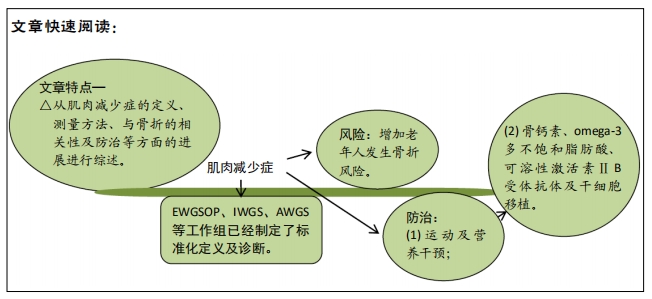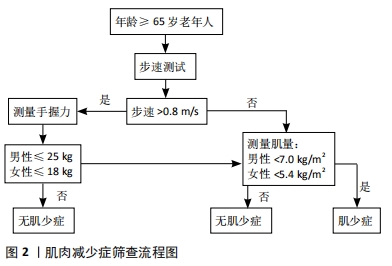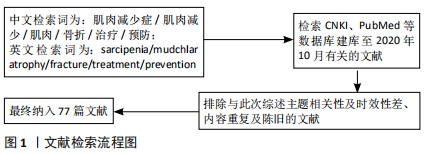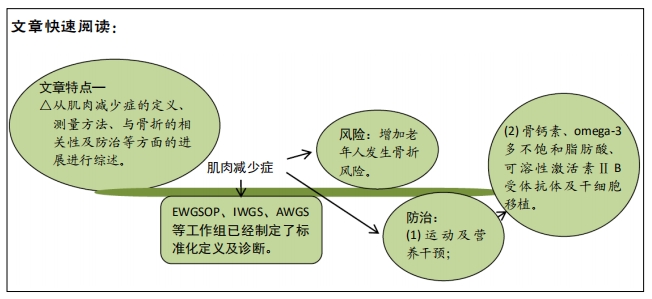[1] SHAFIEE G, KESHTKAR A, SOLTANI A, et al. Prevalence of sarcopenia in the world: a systematic review and meta- analysis of general population studies. J Diabetes Metab Disord. 2017;16(1):21.
[2] HIDA T, SHIMOKATA H, SAKAI Y, et al. Sarcopenia and sarcopenic leg as potential risk factors for acute osteoporotic vertebral fracture among older women. Eur Spine J. 2016;25(11):3424-3431.
[3] Olgun Yazar H, Yazar T. Prevalence of sarcopenia in patients with geriatric depression diagnosis. Ir J Med Sci. 2019;188(3):931-938.
[4] VERONESE N, DEMURTAS J, SOYSAL P, et al. Sarcopenia and health-related outcomes: an umbrella review of observational studies. Eur Geriatr Med. 2019;10:853-862.
[5] BRUYÈRE O, BEAUDART C, ETHGEN O, et al. The health economics burden of sarcopenia: a systematic review. Maturitas.2019; 119: 61-69.
[6] Rosenberg IH. Sarcopenia: origins and clinical relevance. J Nutr. 1997;127(5 Suppl):990S-991S.
[7] 中华医学会骨质疏松和骨矿盐疾病分会 .肌少症共识[J].中华骨质疏松和骨矿盐疾病杂志,2016,9(3):215-227.
[8] DENNISON EM, SAYER AA, COOPER C. Epidemiology of sarcopenia and insight into possible therapeutic targets. Nat Rev Rheumatol. 2017; 13(6):340-347.
[9] RONG S, WANG L, PENG Z, et al. The mechanisms and treatments for sarcopenia: could exosomes be a perspective research strategy in the future? J Cachexia Sarcopenia Muscle. 2020;11(2):348-365.
[10] CRUZ-JENTOFT AJ, BAEYENS JP, BAUER JM, et al. Sarcopenia: European consensus on definition and diagnosis: Report of the European Working Group on Sarcopenia in Older People.Age Ageing. 2010;39(4):412-423.
[11] CRUZ-JENTOFT AJ, BAHAT G, BAUER J, et al. Sarcopenia: revised European consensus on definition and diagnosis. Age Ageing. 2019;48(1):16-31.
[12] ABELLAN VAN KAN G, ANDRÉ E, BISCHOFF FERRARI HA, et al. Carla Task Force on Sarcopenia: propositions for clinical trials. J Nutr Health Aging. 2009;13(8):700-707.
[13] HAN A, BOKSHAN SL, MARCACCIO SE, et al. Diagnostic Criteria and Clinical Outcomes in Sarcopenia Research: A Literature Review. J Clin Med. 2018;7(4):70.
[14] FIELDING RA, VELLAS B, EVANS WJ, et al. Sarcopenia: an undiagnosed condition in older adults. Current consensus definition: prevalence, etiology, and consequences.International working group on sarcopenia.J Am Med Dir Assoc. 2011;12(4):249-256.
[15] CHEN LK, LIU LK, WOO J, et al. Sarcopenia in Asia: consensus report of the Asian Working Group for Sarcopenia. J Am Med Dir Assoc. 2014; 15(2):95-101.
[16] SZULC P, FEYT C, CHAPURLAT R. High risk of fall, poor physical function, and low grip strength in men with fracture-the STRAMBO study. J Cachexia Sarcopenia Muscle. 2016;7(3):299-311.
[17] YOON BH, LEE JK, CHOI DS, et al. Prevalence and Associated Risk Factors of Sarcopenia in Female Patients with Osteoporotic Fracture.J Bone Metab. 2018;25(1):59-62.
[18] BATTAFARANO G, ROSSI M, MARAMPON F, et al. Bone Control of Muscle Function. Int J Mol Sci. 2020;21(4):1178.
[19] Chalhoub D, Cawthon PM, Ensrud KE, et al.Osteoporotic Fractures in Men Study Research Group. Risk of Nonspine Fractures in Older Adults with Sarcopenia, Low Bone Mass, or Both. J Am Geriatr Soc. 2015;63(9):1733-1740.
[20] HONG W, CHENG Q, ZHU X, et al. Prevalence of Sarcopenia and Its Relationship with Sites of Fragility Fractures in Elderly Chinese Men and Women. PLoS One. 2015;10(9):e0138102.
[21] ZHANG N, CHOW SKH, LEUNG KS, et al. An animal model of co-existing sarcopenia and osteoporotic fracture in senescence accelerated mouse prone 8 (SAMP8). Exp Gerontol. 2017;97:1-8.
[22] KIM YK, YI SR, LEE YH, et al. Effect of Sarcopenia on Postoperative Mortality in Osteoporotic Hip Fracture Patients. J Bone Metab. 2018; 25(4):227-233.
[23] PILGRIM AL, ROBINSON SM, SAYER AA, et al. An overview of appetite decline in older people. Nurs Older People. 2015;27(5):29-35.
[24] SIESKE L, JANSSEN G, BABEL N, et al. Inflammation, Appetite and Food Intake in Older Hospitalized Patients. Nutrients. 2019;11(9):1986.
[25] ROBINSON SM, REGINSTER JY, RIZZOLI R, et al. Does nutrition play a role in the prevention and management of sarcopenia?. Clin Nutr. 2018;37(4):1121-1132.
[26] BURD NA, GORISSEN SH, VAN LOON LJ. Anabolic resistance of muscle protein synthesis with aging. Exerc Sport Sci Rev. 2013;41(3):169-173.
[27] VALENZUELA RE, PONCE JA, MORALES-FIGUEROA GG, et al. Insufficient amounts and inadequate distribution of dietary protein intake in apparently healthy older adults in a developing country: implications for dietary strategies to prevent sarcopenia. Clin Interv Aging. 2013;8: 1143-1148.
[28] DUAN Y, LI F, LI Y, et al. The role of leucine and its metabolites in protein and energy metabolism. Amino Acids. 2016;48(1):41-51.
[29] GORISSEN SHM, WITARD OC. Characterising the muscle anabolic potential of dairy, meat and plant-based protein sources in older adults. Proc Nutr Soc. 2018;77(1):20-31.
[30] PENNINGS B, BOIRIE Y, SENDEN JM, et al. Whey protein stimulates postprandial muscle protein accretion moreeffectively than do casein and casein hydrolysate in older men. Am JClin Nutr. 2011;93(5):997-1005.
[31] MOORE DR, CHURCHWARD-VENNE TA, WITARD O, et al. Protein ingestion to stimulate myofibrillar protein synthesis requires greater relative protein intakes in healthy older versus younger men. J Gerontol A Biol Sci Med Sci. 2015;70(1):57-62.
[32] PARK Y, CHOI JE, HWANG HS. Protein Supplementation Improves Muscle Mass and Physical Performance in Undernourished Prefrail and Frail Elderly Subjects: A Randomized, Double-Blind, Placebo-Controlled Trial. Am J Clin Nutr. 2018;108(5):1026-1033.
[33] LEWIS RD, LAING EM.Conflicting reports on vitamin D supplementation: Evidence from randomized controlled trials. Mol Cell Endocrinol. 2015; 410:11-18.
[34] CANGUSSU LM, NAHAS-NETO J, ORSATTI CL, et al. Effect of vitamin D supplementation alone on muscle function in postmenopausal women: a randomized, double-blind, placebo-controlled clinical trial. Osteoporos Int. 2015;26(10):2413-2421.
[35] KOTLARCZYK MP, PERERA S, FERCHAK MA, et al. Vitamin D deficiency is associated with functional decline and falls in frail elderly women despite supplementation. Osteoporos Int. 2017;28(4):1347-1353.
[36] ROSENDAHL-RIISE H, SPIELAU U, RANHOFF AH,et al. Vitamin D supplementation and its influence on muscle strength and mobility in community-dwelling older persons: a systematic review and meta-analysis. J Hum Nutr Diet. 2017;30(1):3-15.
[37] RANATHUNGA RMTK, HILL TR, MATHERS JC, et al. Vitamin D in Older People Study group. No effect of monthly supplementation with 12000 IU, 24000 IU or 48000 IU vitamin D3 for one year on muscle function: The vitamin D in older people study. J Steroid Biochem Mol Biol. 2019; 190:256-262.
[38] BEAUDART C, BUCKINX F, RABENDA V, et al. The effects of vitamin D on skeletal muscle strength, muscle mass, and muscle power: a systematic review and meta-analysis of randomized controlled trials. J Clin Endocrinol Metab. 2014;99(11):4336-4345.
[39] MECHLING H, NETZ Y. Aging and inactivity-Capitalizing on the protective efect of planned physical activity in oldage. Eur Rev Aging Phys Act. 2009;6(2):89-97.
[40] KELL KP, RULA EY. Increasing exercise frequency is associated with health and quality-of-life benefits for older adults. Qual Life Res. 2019; 28(12):3267-3272.
[41] PENEDO FJ, DAHN JR. Exercise and well-being: a review of mental and physical health benefits associated with physical activity. Curr Opin Psychiatry. 2005;18(2):189-193.
[42] BORDE R, HORTOBÁGYI T, GRANACHER U. Dose-Response Relationships of Resistance Training in Healthy Old Adults: A Systematic Review and Meta-Analysis. Sports Med. 2015;45(12):1693-1720.
[43] STEWART VH, SAUNDERS DH, GREIG CA. Responsiveness of muscle size and strength to physical training in very elderly people: a systematic review. Scand J Med Sci Sports. 2014;24(1):e1-10.
[44] ZHANG S, CHEN N. Regulatory Role of MicroRNAs in Muscle Atrophy during Exercise Intervention. Int J Mol Sci. 2018;19(2):405.
[45] MATHENY RW JR, CARRIGAN CT, ABDALLA MN, et al. RNA transcript expression of IGF-I/PI3K pathway components in regenerating skeletal muscle is sensitive to initial injury intensity. Growth Horm IGF Res. 2017;32:14-21.
[46] PAPA EV, DONG X, HASSAN M. Resistance training for activity limitations in older adults with skeletal muscle function deficits: a systematic review. Clin Interv Aging. 2017;12:955-961.
[47] NICHOLSON VP, MCKEAN MR, BURKETT BJ. Low-load high-repetition resistance training improves strength and gait speed in middle-aged and older adults. J Sci Med Sport. 2015;18(5):596-600.
[48] MENSHIKOVA EV, RITOV VB, FAIRFULL L,et al. Effects of exercise on mitochondrial content and function in aging human skeletal muscle. J Gerontol A Biol Sci Med Sci. 2006;61(6):534-540.
[49] FANG Z, LI P, JIA W, et al. miR-696 plays a role in hepatic gluconeogenesis in ob/ob mice by targeting PGC-1α. Int J Mol Med. 2016;38(3):845-852.
[50] PARK YM, PEREIRA RI, ERICKSON CB, et al. Time since menopause and skeletal muscle estrogen receptors, PGC-1α, and AMPK. Menopause. 2017;24(7):815-823.
[51] FAN J, YANG X, LI J, et al. Spermidine coupled with exercise rescues skeletal muscle atrophy from D-gal-induced aging rats through enhanced autophagy and reduced apoptosis via AMPK-FOXO3a signal pathway. Oncotarget. 2017;8(11):17475-17490.
[52] ZAMPIERI S, MOSOLE S, LÖFLER S, et al. Physical Exercise in Aging: Nine Weeks of Leg Press or Electrical Stimulation Training in 70 Years Old Sedentary Elderly People. Eur J Transl Myol. 2015;25(4):237-242.
[53] HASSAN BH, HEWITT J, KEOGH JW, et al. Impact of resistance training on sarcopenia in nursing care facilities: A pilot study. Geriatr Nurs. 2016;37(2):116-121.
[54] VLIETSTRA L, HENDRICKX W, WATERS DL. Exercise interventions in healthy older adults with sarcopenia: A systematic review and meta-analysis. Australas J Ageing. 2018;37(3):169-183.
[55] VIKBERG S, SÖRLÉN N, BRANDÉN L, et al. Effects of Resistance Training on Functional Strength and Muscle Mass in 70-Year-Old Individuals With Pre-sarcopenia: A Randomized Controlled Trial. J Am Med Dir Assoc. 2019;20(1):28-34.
[56] LI G, ZHANG L, WANG D, et al. Muscle-bone crosstalk and potential therapies for sarco-osteoporosis. J Cell Biochem. 2019;120(9):14262-14273.
[57] SHEN H, GRIMSTON S, CIVITELLI R, et al. Deletion of connexin43 in osteoblasts/osteocytes leads to impaired muscle formation in mice. J Bone Miner Res. 2015;30(4):596-605.
[58] LIU S, GAO F, WEN L, et al. Osteocalcin Induces Proliferation via Positive Activation of the PI3K/Akt, P38 MAPK Pathways and Promotes Differentiation Through Activation of the GPRC6A-ERK1/2 Pathway in C2C12 Myoblast Cells. Cell Physiol Biochem. 2017;43(3):1100-1112.
[59] TAAFFE DR, NEWMAN AB, HAGGERTY CL, et al. Estrogen replacement, muscle composition, and physical function: The Health ABC Study. Med Sci Sports Exerc. 2005;37(10):1741-1747.
[60] KIM SW, KIM R.The association between hormone therapy and sarcopenia in postmenopausal women: the Korea National Health and Nutrition Examination Survey, 2008-2011. Menopause. 2020;27(5): 506-511.
[61] BIAN A, MA Y, ZHOU X, et al. Association between sarcopenia and levels of growth hormone and insulin-like growth factor-1 in the elderly. BMC Musculoskelet Disord. 2020;21(1):214.
[62] FERLIN A, DE TONI L, AGOULNIK AI, et al. Protective Role of Testicular Hormone INSL3 From Atrophy and Weakness in Skeletal Muscle. Front Endocrinol (Lausanne). 2018;9:562.
[63] BASUALTO-ALARCÓN C, VARELA D, DURAN J, et al. Sarcopenia and Androgens: A Link between Pathology and Treatment. Front Endocrinol (Lausanne). 2014;5:217.
[64] LATRES E, MASTAITIS J, FURY W, et al. Activin A more prominently regulates muscle mass in primates than does GDF8. Nat Commun. 2017;8:15153.
[65] SOUZA TA, CHEN X, GUO Y, et al. Proteomic identification and functional validation of activins and bone morphogenetic protein 11 as candidate novel muscle mass regulators. Mol Endocrinol. 2008;22(12):2689-2702.
[66] PUOLAKKAINEN T, MA H, KAINULAINEN H, et al. Treatment with soluble activin type IIB-receptor improves bone mass and strength in a mouse model of Duchenne muscular dystrophy. BMC Musculoskelet Disord. 2017;18(1):20.
[67] PUOLAKKAINEN T, RUMMUKAINEN P, LEHTO J, et al. Soluble activin type IIB receptor improves fracture healing in a closed tibial fracture mouse model. PLoS One. 2017;12(7):e0180593.
[68] SAKUMA K, AOI W, YAMAGUCHI A. Current understanding of sarcopenia: possible candidates modulating muscle mass. Pflugers Arch. 2015;467(2):213-229.
[69] BUDUI SL, ROSSI AP, ZAMBONI M. The pathogenetic bases of sarcopenia. Clin Cases Miner Bone Metab. 2015;12(1):22-26.
[70] LANDI F, MARZETTI E, LIPEROTI R, et al. Nonsteroidal anti-inflammatory drug (NSAID) use and sarcopenia in older people: results from the ilSIRENTE study. J Am Med Dir Assoc. 2013;14(8):626.e9-13.
[71] DUPONT J, DEDEYNE L, DALLE S, et al. The role of omega-3 in the prevention and treatment of sarcopenia. Aging Clin Exp Res. 2019; 31(6):825-836.
[72] LALIA AZ, DASARI S, ROBINSON MM, et al. Influence of omega-3 fatty acids on skeletal muscle protein metabolism and mitochondrial bioenergetics in older adults. Aging (Albany NY). 2017;9(4):1096-1129.
[73] SMITH GI, ATHERTON P, REEDS DN, et al.Dietary omega-3 fatty acid supplementation increases the rate of muscle protein synthesis in older adults: a randomized controlled trial. Am J Clin Nutr. 2011;93(2):402-412.
[74] COSSU G, BIRCHALL M, BROWN T, et al. Lancet Commission: Stem cells and regenerative medicine. Lancet. 2018;391(10123):883-910.
[75] ROCHETEAU P, VINET M, CHRETIEN F. Dormancy and quiescence of skeletal muscle stem cells. Results Probl Cell Differ. 2015;56:215-235.
[76] HIDAYAT K, CHEN GC, WANG Y,et al. Effects of Milk Proteins Supplementation in Older Adults Undergoing Resistance Training: A Meta-Analysis of Randomized Control Trials. J Nutr Health Aging. 2018;22(2):237-245.
[77] LIAO CD, CHEN HC, HUANG SW, et al. The Role of Muscle Mass Gain Following Protein Supplementation Plus Exercise Therapy in Older Adults with Sarcopenia and Frailty Risks: A Systematic Review and Meta-Regression Analysis of Randomized Trials. Nutrients. 2019; 11(8):1713.
|




